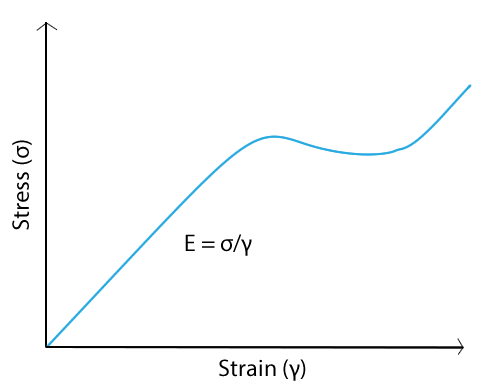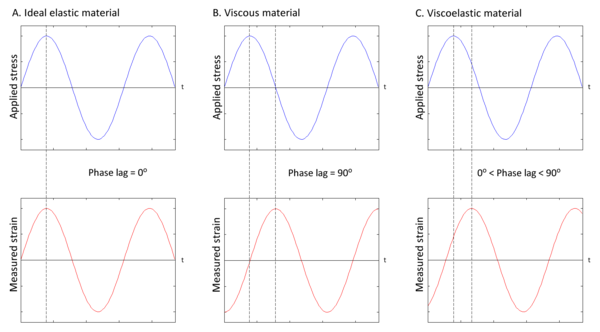| << Chapter < Page | Chapter >> Page > |
The modulus ( E ), a measure of stiffness, can be calculated from the slope of the stress-strain plot, [link] , as displayed in [link] . This modulus is dependent on temperature and applied stress. The change of this modulus as a function of a specified variable is key to DMA and determination of viscoelastic properties. Viscoelastic materials such as polymers display both elastic properties characteristic of solid materials and viscous properties characteristic of liquids; as a result, the viscoelastic properties are often a compromise between the two extremes. Ideal elastic properties can be related to Hooke’s spring, while viscous behavior is often modeled using a dashpot, or a motion-resisting damper.

Creep-recovery testing is not a true dynamic analysis because the applied stress or strain is held constant; however, most modern DMA instruments have the ability to run this analysis. Creep-recovery tests the deformation of a material that occurs when load applied and removed. In the “creep” portion of this analysis, the material is placed under immediate, constant stress until the sample equilibrates. “Recovery” then measures the stress relaxation after the stress is removed. The stress and strain are measured as functions of time. From this method of analysis, equilibrium values for viscosity, modulus, and compliance (willingness of materials to deform; inverse of modulus) can be determined; however, such calculations are beyond the scope of this review.
Creep-recovery tests are useful in testing materials under anticipated operation conditions and long test times. As an example, multiple creep-recovery cycles can be applied to a sample to determine the behavior and change in properties of a material after several cycles of stress.
DMA instruments apply sinusoidally oscillating stress to samples and causes sinusoidal deformation. The relationship between the oscillating stress and strain becomes important in determining viscoelastic properties of the material. To begin, the stress applied can be described by a sine function where σ o is the maximum stress applied, ω is the frequency of applied stress, and t is time. Stress and strain can be expressed with the following [link] .
The strain of a system undergoing sinusoidally oscillating stress is also sinuisoidal, but the phase difference between strain and stress is entirely dependent on the balance between viscous and elastic properties of the material in question. For ideal elastic systems, the strain and stress are completely in phase, and the phase angle (δ) is equal to 0. For viscous systems, the applied stress leads the strain by 90 o . The phase angle of viscoelastic materials is somewhere in between ( Figure 2 ).


Notification Switch
Would you like to follow the 'Physical methods in chemistry and nano science' conversation and receive update notifications?